In this post I will try to explain the basics of the freemium economics, because without those is impossible to understand why free-to-play games have to rely on strict calculations in order to work and scale properly.
Costs
When you run a business you have costs, a f2p business has many costs that I can resume like this:
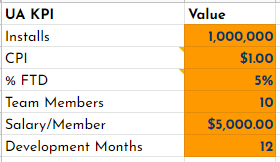
- Installs: number of installs we want to achieve with our acquisition campaigns
- CPI: cost per install. Each install will cost this
- %FTD: first time deposit percentage. Basically, the part of Players that decides to invest something into our game
- Team Members: our team is composed by…
- Salary/Member: the cost per month of each member
- Development Months: the number of months before of publish the complete game, ready for live operations.
If you are working right now in f2p you can notice that those numbers are VERY optimistic. Ad the end of this article I will propose something nearer to the reality. Another thing is that every company has its way of naming things, my approximation is just for the sake of explaining.
Cohorts
When you design a free to play game you should be aware of two things:
- Vast majority of players (in my example 95%, but again it’s optimistic) never pays a dime
- The payers have different spending profiles:

- Minnows: they are the majority of payers and they invest just a little in your game
- Dolphins: they are a big chunk of players and they invest a little bit more. Their spending habit is similar to PC/Console players somehow
- Mermaid: they have a higher acquisitive power, and they decide to invest more over the time in your game
- Whales: they are the real target of your monetization system. Without them, the f2p business is not sustainable. Here’s why:
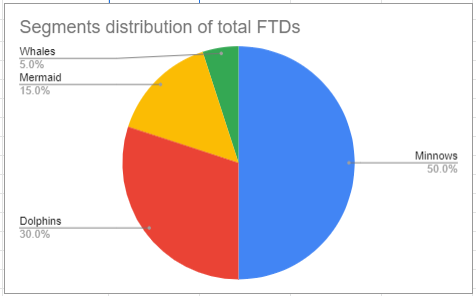
You can clearly see that Whales are the vast minority of all payers (players that spend something). But:
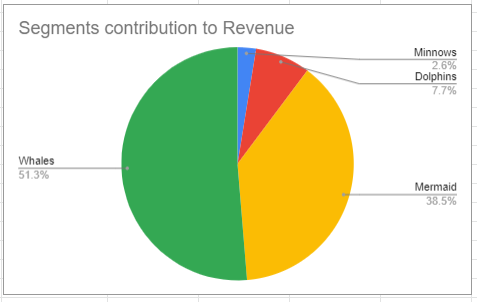
With this configuration, you can see the weight on your revenue of whales and mermaids.
Results
In this perfect scenario, those are the results:
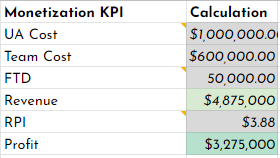
- UA Cost: CPI*Number of Installs. We spent one million dollar just to get people into our game.
- Team cost: Members * Salary/Member * Development Months. We spent six hundred thousand dollars to develop our game. Development costs are cheap compared to marketing.
- FTD: we have fifty thousand people paying something
- Revenue: according to the cohorts, the total revenue is this
- RPI: revenue per install. Total revenue divided per number of installs.
- Profit: what we really earn. The total revenue less the costs. In this ideal case, it works!
We don’t want to make games for whales!
Ok, let’s make a game that doesn’t permit whales to pay that much then! We believe that FOMO, pay to win and lootboxes are the evil, so that we put a maximum cap on our spend depth.
The cohort whales, then, disappears. Let’s say we just have mermaids, that will increment their presence among the cohorts:

In this case, the impact on revenue will be HUGE. Still, with the idealistic costs structure it works! we can have a business:
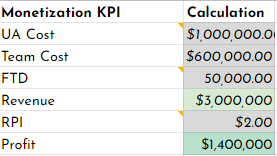
Diablo Resurrection
Lately, a lot of press is writing against the monetization of Diablo Immortal, the last game from Activision Blizzard. They say it’s too agressive, I have a different feeling. To me is not aggressive at all. Let’s study its costs.

A game like that from a company like that will have a cost structure more similar to this:
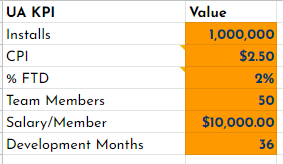
With those cost structure, without targeting whales, the final result will be:
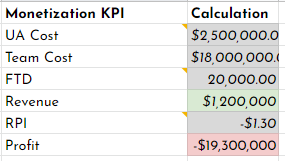
Which is why Diablo Immortal, because of its quality and narrative and everything it gives for free has to target heavily whales. This is for the vast majority of people to have fun. A possible cohort configuration can be:

For the whales to arrive spending ten thousand dollars, the spend depth of Diablo Immortal has to be high. Still, in this way our business barely works:
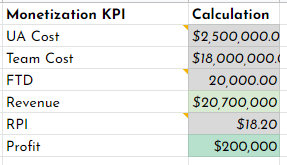
So, I get that many of you don’t agree with f2p and don’t like this business model. But it exists and if you want to be there you have to do very well your math!
Hope this post helps!
Be First to Comment